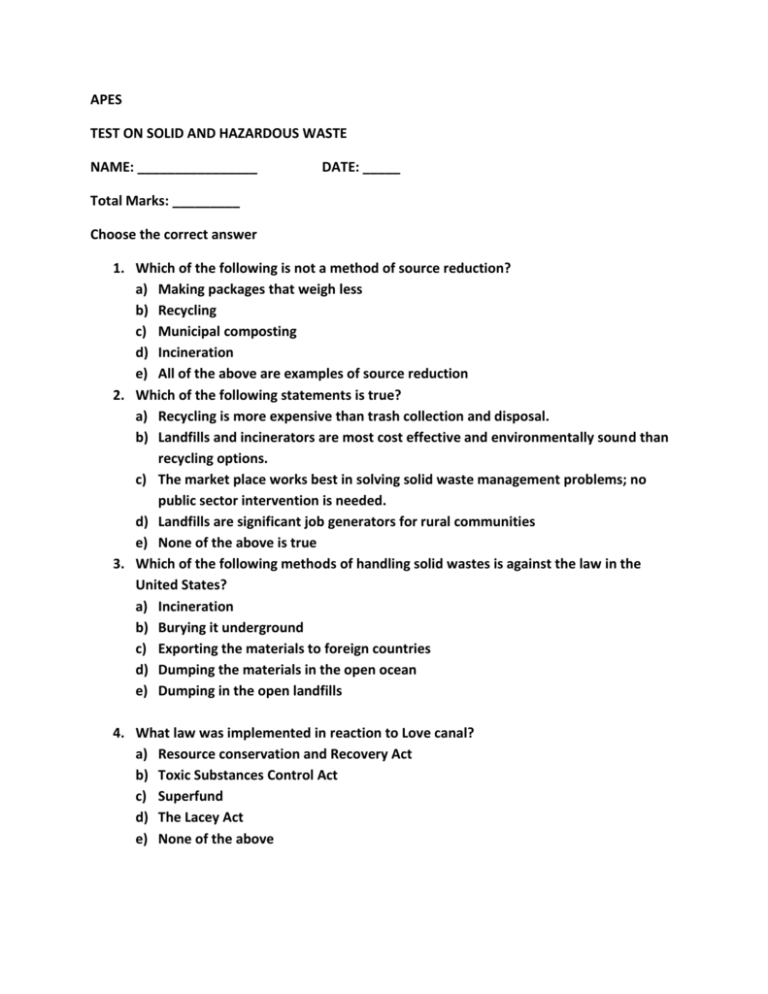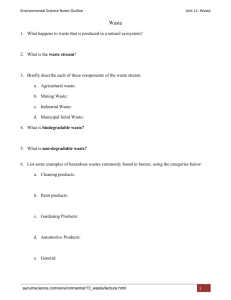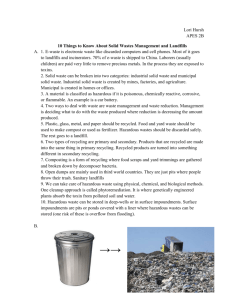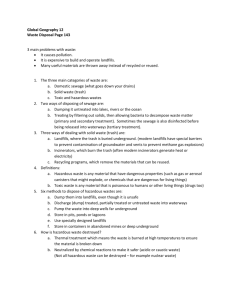APES_Test_on_Solid_waste
advertisement

APES TEST ON SOLID AND HAZARDOUS WASTE NAME: ________________ DATE: _____ Total Marks: _________ Choose the correct answer 1. Which of the following is not a method of source reduction? a) Making packages that weigh less b) Recycling c) Municipal composting d) Incineration e) All of the above are examples of source reduction 2. Which of the following statements is true? a) Recycling is more expensive than trash collection and disposal. b) Landfills and incinerators are most cost effective and environmentally sound than recycling options. c) The market place works best in solving solid waste management problems; no public sector intervention is needed. d) Landfills are significant job generators for rural communities e) None of the above is true 3. Which of the following methods of handling solid wastes is against the law in the United States? a) Incineration b) Burying it underground c) Exporting the materials to foreign countries d) Dumping the materials in the open ocean e) Dumping in the open landfills 4. What law was implemented in reaction to Love canal? a) Resource conservation and Recovery Act b) Toxic Substances Control Act c) Superfund d) The Lacey Act e) None of the above 5. Electronic waste contains all of the following except a) Organochlorides b) Polyvinylchloride c) Copper d) Nickel e) Gold 6. In a low-waste approach, which of the following strategies should be given top priority? a) Incinerate b) Reuse c) Reduce d) Bury e) Recycle 7. All of the following reflect a low-waste approach except a) Extending the useful lifetime for a product b) Designing products that pollute less when used c) Built in obsolescence d) Modular construction for repair e) Eliminate unnecessary packaging. 8. Of the following materials, the most difficult to recycle is a) Glass b) Plastic c) Paper d) Aluminum e) Cardboard 9. Incinerators a) Create many low-paying jobs b) Are inexpensive to build c) Are inexpensive to operate and maintain d) Release toxic substances in fly ash and bottom ash e) Create few high paying jobs 10. Which of the following statements about landfill leaching is false? a) Rain filtering through landfills leaches toxic materials b) Contaminated leachate can seep from the bottom of landfills c) Contaminated groundwater is never problem with landfills d) Older, unlined landfills may have particularly bad water pollution problems. e) None of these answers 11. Of the following methods of reducing hazardous wastes, the most desirable is a) Recycling and reusing hazardous wastes b) Substitution of safer products that don’t produce hazardous wastes c) Conversion into less hazardous and non hazardous materials d) Incineration e) Perpetual storage 12. Evaluations of bioremediation indicate that it is most effective for a) Toxic metals b) Concentrated chemical wastes c) Complex mixtures of toxic chemicals d) A few specific organic wastes e) None of these answers 13. A serious pollutant that accumulates in human bones because it is not excreted is a) Phosphate b) Nitrate c) Lead d) Oxygen-demanding waste e) Mercury 14. Of the following strategies to decrease the landfill volume of packaging material from food and other consumer products, the most energy efficient is a) Recovering plastic packaging material from the waste stream and recycling it b) Recovering metal packaging material from the waste stream and recycling it c) Limiting the size of individual beverage containers made from metal, glass, or plastic. d) Using more packaging materials that are manufactured from raw materials that are renewable. e) Promoting the use of reusable containers for consumer goods. 15. Most municipal solid waste in the United States is disposed of in a) The oceans b) Sanitary landfills c) Deep wells d) Open dumps e) Abandoned mines 16. Which of the following would encourage recycling? a) Decreasing government purchases of recycled materials b) Decreasing subsidies for recycling c) Decreasing taxes on resource-extracting industries. d) Decreasing taxes on recycled material e) Decreasing fees for using landfills. 17. Critics of incineration of municipal solid waste suggest that it may not be the best solution for the future, for which of the following reasons? a) Incineration produces ash that increases landfill volume. b) Incineration generates methane c) Incineration involves advanced technology. d) Incineration contributes to air pollution e) Incineration requires large energy input. 18. An advantage of recycling aluminum rather than depositing it in landfills is that aluminum can be a) Produced from recycled metal using much less energy than is required for its production from aluminum ore. b) Produced from ore that is chemically reactive and dangerous to transport, store, and process c) Produced from ore that is scarce and found primarily in remote, inhospitable regions at high altitudes. d) Absorbed by plants and then biomagnified in both terrestrial and aquatic food chains. e) Leached from landfills in the form of Al3+ ions that could increase the pH of lakes and streams. 19. Integrated waste management employs all of the following EXCEPT a) Using refillable soft-drink bottles b) Using disposable diapers instead of cloth diapers c) Using reusable canvas bags instead of plastic or paper bags. d) Using tires for the construction of artificial reefs. e) Redesigning automobiles to replace steel parts with aluminum and plastic parts. 20. Regulations that deal directly with the disposal of hazardous materials in the United States include which of the following? I. RCRA II. Clean Water Act III. Clean Air Act a) I only b) II only c) II only d) I and II only e) I, II and III Section –B 1. The city of Fremont has a large brownfield located along the Fremont River. The brownfield is former industrial site where contamination by hazardous chemicals impedes redevelopment. The city council is considering two options for reclaiming the brownfield. The first option is to excavate and remove the contaminated soil, and the second option is to decontaminate the soil on the site using vegetation. [8] a) Assume that the city council chooses the first option. Describe TWO problems that result from removing the contaminated soil from the brownfield. b) Assume that the city council chooses the second option. Explain how vegetation could be used to decontaminate the soil. Discuss one advantage and one disadvantage of using this reclamation method. c) Identify and describe (i) One method currently used to reduce the production of hazardous waste and (ii) One method of legally disposing of hazardous waste. 2. [10] 3. Briefly explain the two major problems associated with sanitary landfills. [3] 4. List the advantages and disadvantages of incineration of solid waste. [4] 5. How do source reduction, reuse, and recycling reduce the volume of solid waste? [5] 6. How are dioxins and mercury harmful to human beings? [2] 7. Explain the biological method used to treat hazardous waste. Give one advantage and disadvantage of one of the methods[4] 8. What are the advantages and disadvantages of deep well injection method of disposal of hazardous waste? [3] 9. List one advantage of composting. [1] 9. IS RECYCLING SMART ECONOMIS? [10] PAPER 2000 Answers 1. D 2. E 3. D 4. C 5. A 6. C 7. C 8. B 9. D 10. C 11. C 12. D 13. C 14. E 15. B 16. D 17. D 18. A 19. B 20. A








